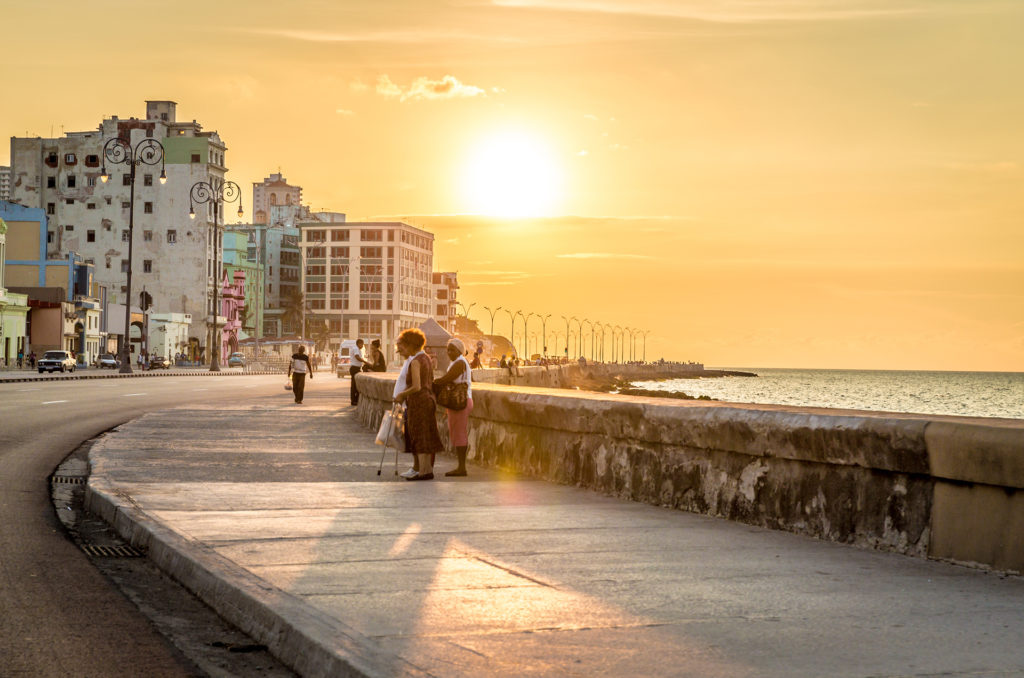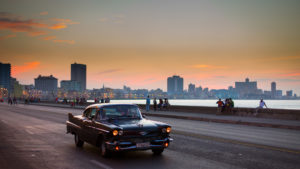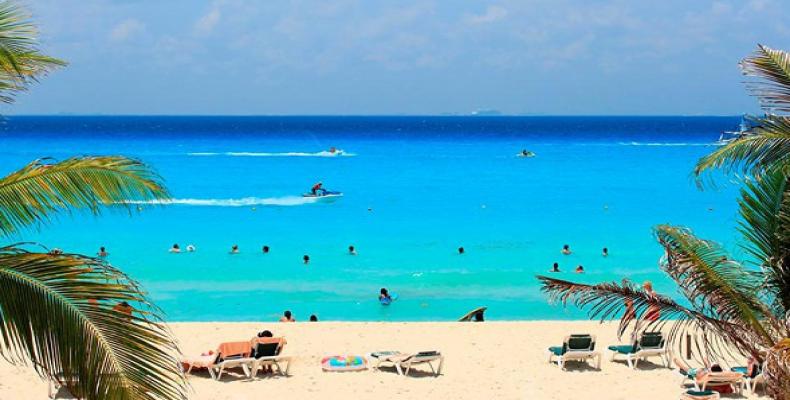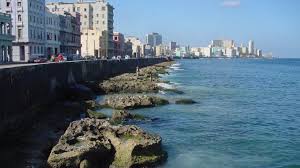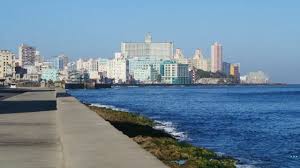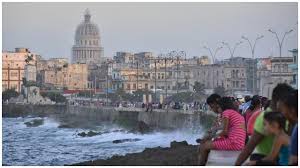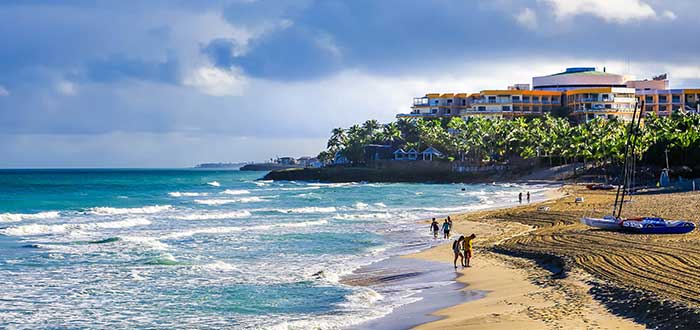A FAMOUS CUBAN PHRASE: “UNTIL THE MALECÓN DRIES UP”. HISTORY. PHOTOS/VIDEOS
For months now, in Cuba there had been talking about the project to raise the wall of the Malecón in Havana to prevent the waves from penetrating more than necessary in the areas adjacent to it.
There is talk of increasing up to 1.25 meters, this is 65 centimeters higher than the wall. Opponents of this government initiative argue that the increase in the wall would prevent the contemplation of the sea and would make it difficult for many to sit down and fall in love or simply take the fresh air in what has been defined as the longest bench in the world and that gives a touch distinctive to the city that without it would not be the same. It also talks about the enormous amount of resources that such an effort would collect in a city that has more important and even peremptory construction needs. Surely the higher the wall is, the more the waves would jump over it.
https://youtu.be/rEgXnJwEUmM
Press ^ Here
THE HAVANA MALECÓN
CONSTRUCTION OF THE MALECÓN OF HAVANA
The Malecón is the first avenue that deserves such a name in Havana. Its construction was not due to the intention of improving traffic, but for reasons of health and decoration. Before its construction, the reefs, true garbage dumps, appeared covered with all kinds of filth, while the traveler who arrived by sea saw, upon entering the city, the ugly and depressing spectacle of the bottoms and patios of the houses along the road. of San Lázaro. With the Malecón, the panorama changed and soon Havana was able to show, at its entrance, a semicircle lined with new buildings and at all times, but especially at night, a place endowed with singular beauty.
It runs between two colonial fortresses, La Punta and La Chorrera. Its eight kilometers of the extension were built in sections. Construction began in the days of the first US military intervention, under the command of Governor Leonardo Wood. The first stone was laid on May 6, 1901, and a year later, on May 20, when the Republic was established, it reached Calle Crespo, with about 500 meters built of a project that included trees and lampposts on the wall, an idea that was abandoned with the arrival of the first north.
The work continued and in 1909 it reached Belascoaín and in 1916 the tower of San Lázaro, which forced to fill in the cove of the same name (in front of the Hermanos Ameijeiras hospital) with its 93 meters wide at its mouth and 5.5 meters deep. Yet something tremendous happened.
When the cyclone of September 9, 1919, the sea lifted this section in weight and threw huge stones and pieces of concrete at a considerable distance, with damage and flooding never seen or remembered by the public, a situation that not a few engineers attributed to construction from the Malecón. Criteria that caused that the section of the cove was not rebuilt until 1923 when two years earlier the wall had reached from the tower to 23rd Street. In this section, specifically from the promontory of the Santa Clara Battery, where it would be built in 1930, the Hotel Nacional, up to Calle O, decided to separate the wall about 30 meters from the coastline and fill in an area of more than 104,000 square meters in order to erect the monument to Maine there. This happened in 1923, during the Alfredo Zayas government. From there, the extension of the wall to battery number 3, where the US Embassy would be built, and battery number 4, the current José Martí sports park, was contemplated, but not carried out. The terrible cyclone of 26 destroyed the Maine Monument, which had to be rebuilt.
In 1930, President Gerardo Machado and Carlos Miguel de Céspedes, their minister (secretary) of Public Works, took the Malecón to G. Batista Street, and in 1955, they took it to Paseo. New difficulty in advancing the wall to the west. The Palacio de Convenciones y Deportes, in Paseo y Mar, where the Fountain of Youth is located, was placed in front of the Riviera hotel. The demolition of that building and the construction of the Sports City were imposed.
Since 1950 there was the idea of extending the Malecón to 12th Street, in El Vedado, from where a large suspension bridge would connect with First Avenue of the Miramar district, until near where the Rosita de Hornedo hotel, current Sierra Maestra, would be built. At that time, to the west of the Palacio de Los Deportes, the wall had not been built nor was there any building. It was the construction of the Calzada tunnel, under the Almendares River, in 1958, which allowed the Malecón to be carried to its current end.
DIFFERENT NAMES OF THE HABANERO MALECÓN
Each of these sections has its name. * The first, which runs from Castillo de la Punta to Maceo Park, was originally called Avenida del Golfo and in 1902 it was renamed Avenida de la República, but in 1908 it was Avenida del General Maceo, and the following year Avenida Antonio Maceo, which is his current name.
* The next section, which passes by the side of the National Hotel, where the Maine monument was erected, is called Washington Avenue, and continues, to G Street, Pi y Margall Avenue, in homage to the Spanish politician and journalist, born in Barcelona, who presided over the first Republic, in 1873. He was the only Republican leader who did not allow himself to be carried away by the nationalist ardor and advocated the independence of Cuba. * The last section is Aguilera Avenue, by Francisco Vicente Aguilera, the richest man in the East, who did not hesitate to renounce his position and fortune to join the armed struggle in 1868 and who would die in exile in the most complete misery.
In 1927, in Machado’s time, his minister Carlos Miguel de Céspedes extended the Malecón in the opposite direction. From La Punta to the beginning of the docks, where the old Harbor Master’s Office was located, which then disappeared. It is a section that lacks the beauty that the open sea gives to the remaining sections, but it has the charm of the vegetation and its amplitude that allows the Luz Caballero Park to extend to its side, with monuments dedicated to Cuban thinkers, and where The Municipal Amphitheater, a beautiful Greek-style open-air theater, has a place. This section received the name of Avenida de Carlos Manuel de Céspedes.
This section meant winning 111,000 square meters to the sea, which would be used largely for parks and road solutions. The wall works, without the filling, resulted in an investment of more than two million pesos, and that of the filling, another million.
Malecón is a generic name and is synonymous with dock. We Cubans give it a category of a proper name, so we write it with a capital initial letter. Havana cannot be conceived without the Ramp. Nor without its Malecón.
But we are sure that the famous Cuban phrase about the Malecón will never be fulfilled, nor will the constant beating of its waves.
UNA FRASE CUBANA FAMOSA: “HASTA QUE SE SEQUE EL MALECÓN”. HISTORIA. PHOTOS/VIDEOS
Desde hace ya meses que se viene hablando en Cuba del proyecto de alzar el muro del Malecón de la Habana para evitar que las olas penetren más de la cuenta en las areas colindantes a ella.
Se habla de aumentar hasta 1.25 metros, esto es 65 centimetros mas alto al muro. Los opuestos a esta iniciativa gubernamental alegan que el aumento al muro impedirian la contemplación del mar y dificultaria para muchos la posibilidad de sentarse a enamorar o sencillamente tomar el fresco en lo que se ha definido como el banco más largo del mundo y que otorga un toque distintivo a la ciudad que sin el no seria la misma. Tambien se habla de la enorme cantidad de recursos que recabaria dicho empeño en una ciudad que tiene necesidades construtivas mas importantes e incluso perentorias. De seguro que mientras el muro sea más alto, más saltarian las olas sobre el.
https://youtu.be/3s57K70l8-k
Presione ^ Aqui
EL MALECÓN DE LA HABANA
CONSTRUCCION DEL MALECÓN DE LA HABANA
El Malecón es la primera avenida que merece tal nombre en La Habana. Su construcción no obedeció a la intención de mejorar el tránsito, sino a razones de salubridad y ornato. Antes de su construcción los arrecifes, verdaderos basureros, aparecían cubiertos de toda suerte de inmundicias, mientras que el viajero que arribaba por mar veía, al entrar a la ciudad, el feo y deprimente espectáculo de los fondos y patios de las casas de la calzada de San Lázaro. Con el Malecón el panorama cambió y pronto pudo La Habana mostrar, a su entrada, un semicírculo bordeado de nuevos edificios y a toda hora, pero en especial por las noches, un paraje dotado de singular hermosura.
Corre entre dos fortalezas coloniales, la de la Punta y la de la Chorrera. Sus ocho kilómetros de extensión se construyeron por tramos. Empezó a construirse en los días de la primera intervención militar norteamericana, bajo el mando del gobernador Leonardo Wood. La primera piedra se colocó el 6 de mayo de 1901, y un año después, el 20 de mayo, al instaurarse la República, llegaba hasta la calle Crespo, con unos 500 metros construidos de un proyecto que contemplaba árboles y farolas sobre el muro, idea que se abandonó con la llegada del primer norte.
Prosiguió la obra y en 1909 llegó a Belascoaín, y en 1916 al torreón de San Lázaro, lo que obligó a rellenar la caleta del mismo nombre (frente al hospital Hermanos Ameijeiras) con sus 93 metros de ancho en su boca y 5,5 metros de profundidad. Sucedió sin embargo algo tremendo.
Cuando el ciclón del 9 de septiembre de 1919, el mar levantó en peso ese tramo y arrojó enormes piedras y trozos de concreto a bastante distancia, con daños e inundaciones nunca vistos ni recordados por la ciudadanía, situación que no pocos ingenieros atribuyeron a la construcción del Malecón. Criterios que ocasionaron que el tramo de la caleta no se reconstruyó hasta 1923 cuando desde dos años antes el muro llegaba desde el torreón a la calle 23. En este tramo, en específico desde el promontorio de la batería de Santa Clara, donde se edificaría en 1930 el Hotel Nacional, hasta la calle O, se impuso separar el muro unos 30 metros del litoral y rellenar un área de más de 104 000 metros cuadrados a fin de erigir allí el monumento al Maine. Esto ocurrió en 1923, en tiempos del gobierno de Alfredo Zayas. Desde allí se contempló, pero no se ejecutó, la prolongación del muro hasta la batería número 3, donde se construiría la Embajada norteamericana, y la batería número 4, actual parque deportivo José Martí. El terrible ciclón del 26 destruyó el monumento al Maine, que hubo necesidad de reconstruir.
En 1930 el presidente Gerardo Machado y Carlos Miguel de Céspedes, su ministro (secretario) de Obras Públicas llevaron el Malecón hasta la calle G. Batista, en 1955, lo llevó hasta Paseo. Nueva dificultad en el avance del muro hacia el oeste. Se le interpuso el Palacio de Convenciones y Deportes, en Paseo y Mar, donde se halla la fuente de la juventud, frente al hotel Riviera. Se impuso la demolición de ese inmueble y la construcción de la Cuidad Deportiva.
Desde 1950 existía la idea de prolongar el Malecón hasta la calle 12, en El Vedado, desde donde un gran puente colgante enlazaría con la avenida Primera del reparto Miramar, hasta cerca de donde se construiría el hotel Rosita de Hornedo, actual Sierra Maestra. En ese tiempo, al oeste del Palacio de los Deportes, no se había construido el muro ni había edificación alguna. Fue la construcción del túnel de Calzada, bajo el río Almendares, en 1958, lo que permitió llevar el Malecón hasta su término actual.
DISTINTOS NOMBRES DEL MALECÓN HABANERO
Cada uno de esos tramos tiene su nombre. * El primero, que corre desde el castillo de la Punta hasta el parque Maceo, se llamó originalmente Avenida del Golfo y en 1902 pasó a llamarse Avenida de la República, pero en 1908 fue la Avenida del General Maceo, y al año siguiente, Avenida Antonio Maceo, que es su nombre actual.
* El tramo siguiente, que pasa por el costado del Hotel Nacional, donde se erigió el monumento al Maine, se llama Avenida Washington, y sigue, hasta la calle G, la Avenida Pi y Margall, en homenaje al político y periodista español, nacido en Barcelona, que presidió la primera República, en 1873. Fue el único líder republicano que no se dejó arrastrar por el ardor nacionalista y abogó por la independencia de Cuba. * El último tramo es la Avenida Aguilera, por Francisco Vicente Aguilera, el hombre más rico de Oriente, que no vaciló en renunciar a su posición y fortuna para incorporarse a la lucha armada en 1868 y que moriría en exilio en la más completa miseria.
En 1927, en tiempos de Machado, su ministro Carlos Miguel de Céspedes extendió el Malecón en sentido contrario. Desde la Punta hasta el comienzo de los muelles, donde se hallaba la vieja Capitanía del Puerto, que desapareció entonces. Es un tramo que carece de la belleza que el mar abierto regala a los tramos restantes, pero tiene el encanto de la vegetación y su amplitud que permite que a su vera se extienda el parque Luz Caballero, con monumentos dedicados a pensadores cubanos, y donde encuentra cabida el Anfiteatro Municipal, bello teatro al aire libre de estilo griego. Este tramo recibió el nombre de Avenida de Carlos Manuel de Céspedes.
Este tramo significó ganarle 111 000 metros cuadrados al mar, que se destinarían en gran parte a parques y soluciones viales. Las obras del muro, sin el relleno, resultaron una inversión de más de dos millones de pesos, y la del relleno, otro millón.
Malecón es un nombre genérico y es sinónimo de dique. Los cubanos le damos categoría de nombre propio por lo que lo escribimos con letra inicial mayúscula. No se concibe La Habana sin la Rampa. Tampoco sin su Malecón.
Pero de lo que estamos seguros que la famosa frase cubana sobre el malecón nunca se cumplirá, ni el constante batir de sus olas.
Agencies/ Wiki/ Ciro Bianchi/ Juan de las Cuevas/ Emilio Roig/ Extractos/ Excerpts/ Internet Photos/ YouTube/ Arnoldo Varona/ www.TheCubanHistory.com
THE CUBAN HISTORY, HOLLYWOOD.



